Two bright new supernovae are now within the range of amateur telescopes in the western sky at nightfall.
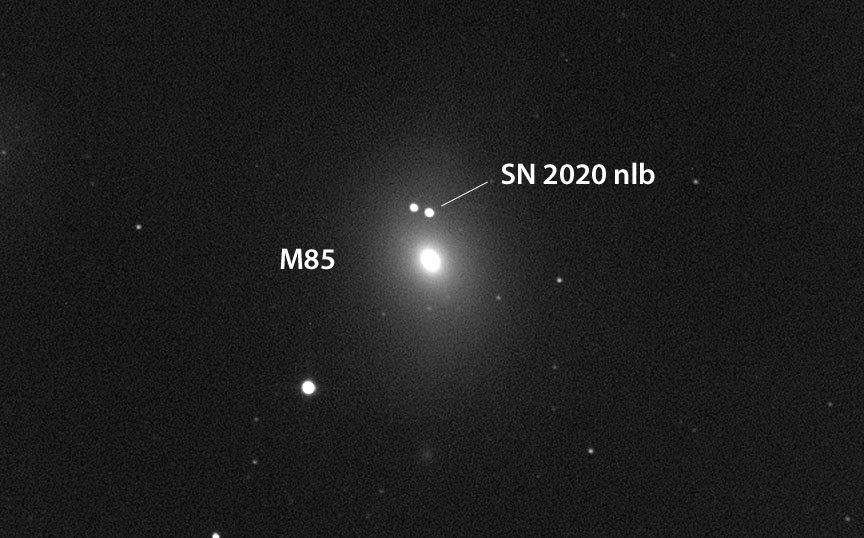
Gianluca Masi
If you want to see a supernova in your lifetime, why wait around for Betelgeuse to blow up? If you have a 6-inch telescope and access to a dark sky, you can see one right now. Two actually. Both are visible in the western sky at nightfall in the neighboring constellations Virgo and Coma Berenices.
The first of the pair, dubbed 2020nlb, was discovered by the Asteroid Terrestrial-impact Last Alert System (ATLAS) on June 25th in the 10th-magnitude galaxy M85. Located in Coma Berenices 60 million light-years from Earth, M85 is an elliptical galaxy a quarter again as large our Milky Way. The "M" stands for Charles Messier, an 18th century French astronomer who compiled a list of galaxies, star clusters and nebulae he stumbled on during searches for his favorite prey, comets.
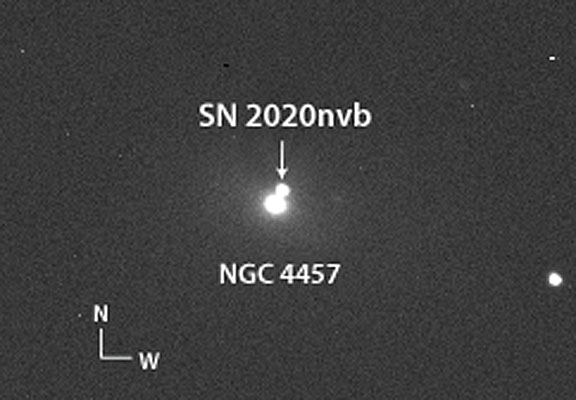
Gianluca Masi
Japanese amateur and prolific supernova hunter Koichi Itagaki nabbed SN 2020nvb on July 1 in NGC 4457, a spiral galaxy in Virgo located about 55 million light-years away. Each of these newly discovered supernovae occurred in a close binary system where a tiny, superdense white dwarf star orbits a normal star. The dwarf is only about the size of Earth, but its matter is packed so tightly the object has nearly the same mass as the Sun. You'd need a massive crane to lift even a thimbleful!
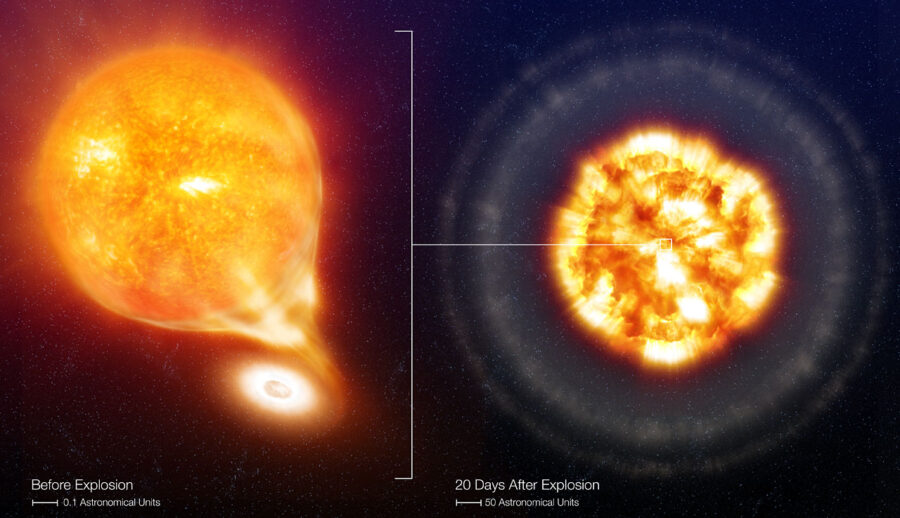
ESO
The dwarf's powerful gravity siphons material from its companion onto its surface until the added weight and pressure of the stolen material initiates a runaway nuclear fusion within the dwarf and boom! — it explodes cataclysmically as a supernova.
Like breakfast cereals, supernovas come in a variety of types but are broadly divided into Type Ia (white dwarf explosions in close pairs) and Type II (massive star blasts like Betelgeuse). Both 2020nlb and 2020nvb are Type Ia supernovae, among the brightest "candles" in the universe. In fact, the most luminous Type Ia supernovae routinely outshine their entire host galaxy! Betelgeuse is a standalone, gigantic star. One day it will run out of nuclear fuel, halt fusing new elements, and then collapse and explode as a supernova as bright as the gibbous Moon.
The M85 supernova quickly brightened from magnitude 16.8 at discovery to 12.2 on July 7 and may still be getting brighter. The NGC 4457 supernova is even brighter at magnitude 11.9 and located a little northwest of the center of the galaxy's nucleus.
Star-hop to a Supernova
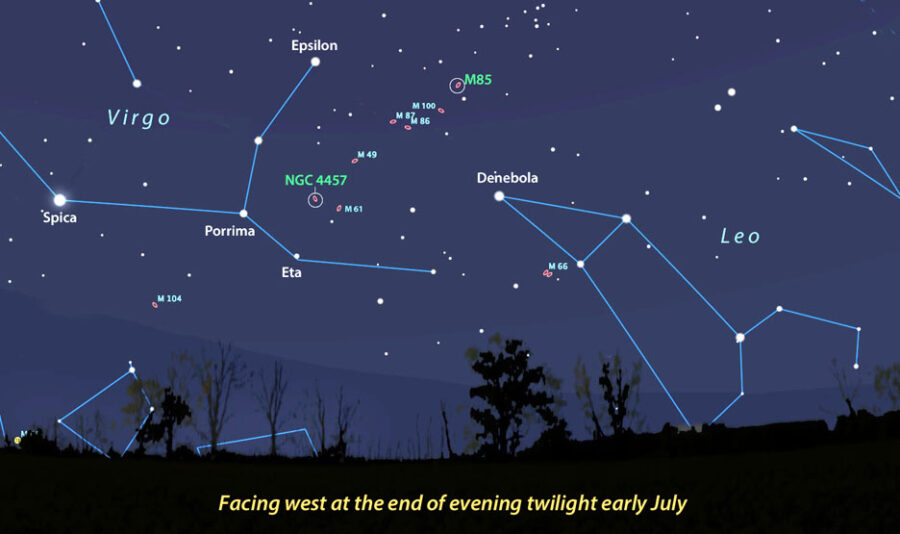
Stellarium
Now that the moon is past full, it's on its way out of the evening sky, so you'll have the darkness you'll need to spot these distant explosions in smaller scopes. I encourage you to start looking for the pair as soon as it gets dark, when they're highest in the sky and least affected by the atmosphere.
Begin at Denebola, an obvious 2nd-magnitude star about two fists (20°) high in the western sky at twilight's end, and star hop to M85 using the chart below as guidance. Or start at Epsilon Virginis. Then use the photo to identify the supernova. To reach NGC 4457, start star-hopping at either Porrima or Eta Virginis in Virgo.
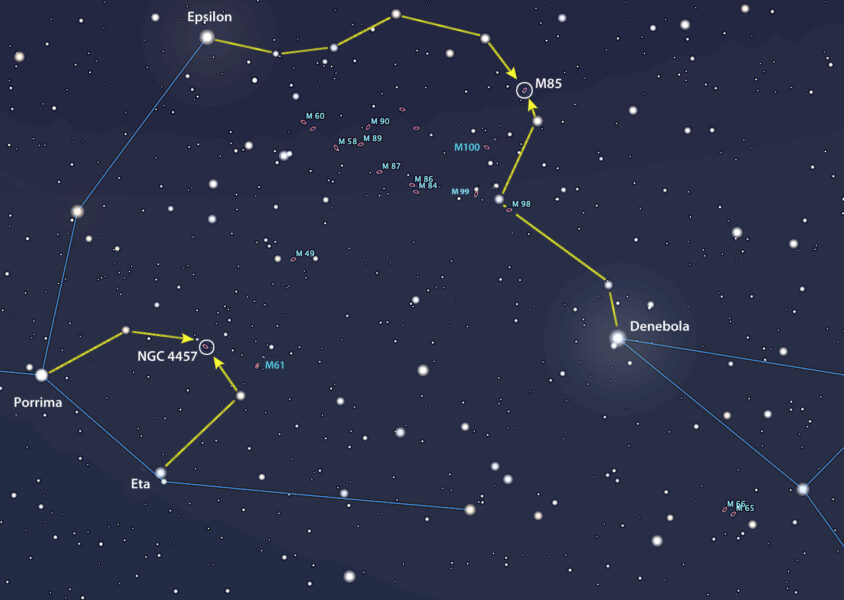
Stellarium with additions by the author
Use your lowest magnification while star-hopping. Once you've arrived at each galaxy increase the power to 100x or higher to pick out the supernovae. Then let your imagination go. Picture each point of light as a star in the process of self-destruction, one of the most powerful and creative acts in the universe.
Creative? You bet. Supernovae explosions seed interstellar space with lots of elements, including familiar ones like iron, nickel, lead and gold. All that material regathers into great clouds of gas and dust called nebulae, within which are born new generations of stars and planets . . . and well, who knows what else, including life.
 5
5









Comments
Tom-Reiland
July 7, 2020 at 5:29 pm
Bob, I was able to observe the SN in M85 last night. This is the 116 SN that I've observed. It was easy to spot next to the foreground star. I didn't get a chance to search for the one in NGC 4457 because of haze (or dust from the Sahara) and light pollution in that area of the sky above Pittsburgh. The same problem prevented me from hunting for Comet Lemmon. I search for SNs in other galaxies when I have good conditions. I discovered the SN in M51 in 2011 and I was the first to report it, but I was second on the 1998 SN in NGC 7541.
BTW, Comet Lemmon was an naked-eye object, though barely, this morning for the first time in the four straight mornings that I've observed it.
You must be logged in to post a comment.
Bob KingPost Author
July 7, 2020 at 8:04 pm
Hi Tom,
Wow, you discovered the M51 SN? I got really excited about that one given its location but as I recall it was on the faint side. A much belated congratulations, Tom!
You must be logged in to post a comment.
Tom-Reiland
July 8, 2020 at 3:18 pm
Error on the above post. That should be Comet NEOWISE and not Lemmon. Tired after four nights in a row. I hope to get a chance for Lemmon and the SN in NGC 4457 tonight.
You must be logged in to post a comment.
Feijo
July 11, 2020 at 9:49 am
Bob, thank you for another excellent article! I was able to observe and image both SN this week. Actually, there is another interesting case, SN 2020nif in NGC 4939, a beautiful face-on galaxy south of the two you mentioned.
One question: what happens to the companion star? Is it completely obliterated, I suppose?
Best regards!
Fabio Feijo
Canopus Observatory
Brazil
You must be logged in to post a comment.
Martian-Bachelor
July 17, 2020 at 3:49 pm
BTW - NGC 4457 is just a few degrees almost due N of the famous quasar 3C273, which is about the same magnitude as the SN. There was a close-up chart of this field not that long ago in the print edition.
Also, the Revised Shapley-Ames Catalog of Bright Galaxies has M85 classified as type "S0-3 pec", not elliptical as stated in the text. I've posted a copy of the Palomar Observatory Sky Survey (POSS) photo of it, courtesy of NED (NASA Extragalactic Database) at Cal Tech, with a 20 arc-minute square field showing two neighboring smaller galaxies at https://visns.neocities.org/VISNS_pics/NGC_4382_DSS.jpg. (I'm pretty sure this was the red exposure not the blue one.)
You can see the field star just E-NE of the SN, as well as the fact that the SN lies pretty much right on the galaxy's major axis. I guess it gets its "pec" (peculiar) rating on account of its isophotes seeming to be skewed a little, at least to my eye.
I was able to get four clear nights of observations with good conditions the 8th through the 11th -- even though my sky's worst in the SW -- before the monsoon season has since moved into the Southwest US here. We really need the rain.
You must be logged in to post a comment.
You must be logged in to post a comment.